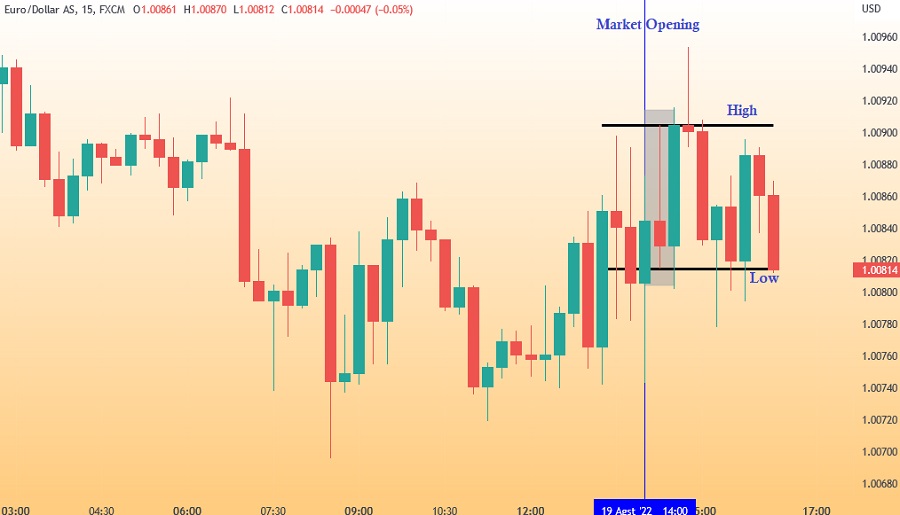The 15-minute strategy with candlestick is one of the popular setups for day traders. Find out why and how it works below.
Scalpers might prefer lower time frames to capitalize on more trading opportunities. On the other hand, day traders will prefer the 15-minute chart to earn profits from bigger price movements during a trading day. Similar to other trading strategies, this strategy requires practice and once traders can learn it well and execute it accordingly, they will start reaping the benefits.

Step 1: Identify the Market Sentiment
It is important to understand the sentiment of whatever market you are trading because this will make it easier to determine the best way to implement your trading strategy. The market sentiment is the direction in which the market is moving whether it is an uptrend, a downtrend, or a sideways movement. It should be noted that a trending market is where the 15-minute candlestick strategy works best.
Step 2: Market Opening
The market opening is crucial to this strategy because the result would be dependent on the type of market movement. If the market is trending (higher price movement), the risk-to-reward ratio is high and the trader has increased chances of success.
However, if the market movement is sideways which indicates small price movement, the risk-to-reward ratio would be low thus reducing the chances of success while increasing the possibility of failure.
Step 3: Patience
A major reason why people fail in trading is a lack of patience. Sometimes, traders get so excited that they do not wait for 15 minutes for the first candle to close after the opening of the market. As a result, they end up placing their trades within 5 minutes of the market opening and this early entry usually leads to significant losses.
The market tends to take about 15 minutes or more to stabilize after which the real trend becomes clear. Some assets can suddenly reverse direction within those 15 minutes and an early entry would most likely result in losses once the trader has failed to confirm the right direction. So, patience is most definitely important when using this strategy.
Step 4: Entry
It is crucial to enter a trading position at the right time and it is a skill that all traders must learn. Once the first 15-minute candle closes, two lines should be marked on the high and low of the candle. These lines will function as the reference point for entering the trade. Once the lines have been drawn, the chart should be switched to a 5-minute time frame.

After switching from a 15-minute to a 5-minute chart, you will be looking at 3 candles. These 3 candles on the 5-minute chart will provide more information than 1 candle on the 15-minute chart. When the next candle which is the 4th candle breaks any of the two lines drawn initially (whether upper or lower) and then closes above them, this is the point where you enter the trade.
Step 5: Target
Targets are usually set to between 0.5% and 1% of the asset price in the market. When the market movement is sideways, then using the target of 0.5% is advisable. The target of 1% can then be used when the market is trending.
While there are other methods to set targets, it is still much better to set in percentage as it produces higher winning rates and reduces the amount of risk involved.
Step 6: Stop Loss
Placing the stop loss depends on the size of the first 15-minute candle. If the first 15-minute candle has a size that ranges between small and medium or has a long wick, then the stop loss should be positioned at the high or low of the candle which is to be determined by the direction of trading.
However, if the first 15-minute candle is very broad, then the stop loss should be positioned in the middle. The position of the stop loss can always be modified once the market begins to move in the direction predicted by the trader.
In conclusion, these are the six steps that you need to follow to implement the 15-minute candlestick trading strategy. For other strategies to try in a 15-minute chart, you could try learning "Best MACD Strategy for 15-Minute Charts".

 Dedicated FREE FOREX VPS
Dedicated FREE FOREX VPS Free FOREX Virtual Private Server
Free FOREX Virtual Private Server MT4 Demo Contest, Get $500
MT4 Demo Contest, Get $500 Sign Up for an Account, Claim 60% Deposit Bonus
Sign Up for an Account, Claim 60% Deposit Bonus Free MT4/MT5 VPS 2024
Free MT4/MT5 VPS 2024 Send E-mail and Get Free Merchandise
Send E-mail and Get Free Merchandise $1K Refer a Friend Bonus for Pepperstone Pro clients
$1K Refer a Friend Bonus for Pepperstone Pro clients Maximize Your Earnings with 100% Deposit bonus
Maximize Your Earnings with 100% Deposit bonus Trade to Win, $5,000 Monthly Demo Contest
Trade to Win, $5,000 Monthly Demo Contest Claim 30% + 15% Deposit Bonus from LiteFinance
Claim 30% + 15% Deposit Bonus from LiteFinance












3 Comments
Mahesh L Amin
Jul 12 2023
To Oktavina justine
thanks for giving example for 15 minute candle indentify trade.
can you give similar example on image of 3 candles 5 minutes and 4th one breakout entry and exit and stop loss too for better understanding.
Thanks
Mahesh
Bellerin
Jan 18 2024
Just got a question on this 15-minute candlestick trading strategy. In the article, it talks about placing the stop loss based on the size of the first 15-minute candle. If the candle is small to medium or has a long wick, the stop loss should go at the high or low, depending on the trade direction.
Now, my question is about this Stop Loss thing – is it solely based on visual analysis of the candlestick chart? Because, you know, it's all about reading those candlestick patterns. But what's throwing me off is the timeframe used for determining the stop loss. Is it still 15 minutes, considering that 15-minute trading is often associated with quick scalping? The article also mentions day trading using the 15-minute candlestick approach (sticking to the 15-minute timeframe). Just trying to get a clear picture of the timeframe in play for setting stop losses in this strategy.
Ospina
Jan 21 2024